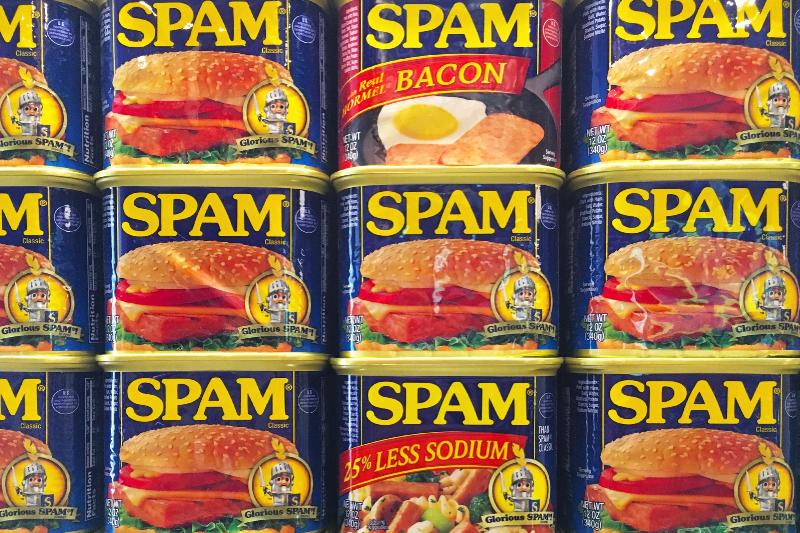What Is SPAM, Anyway?




It shares its name with those annoying emails you don’t want. It comes in a can and is made of…some kind of meat? Whether you grew up eating it and still do or you’ve merely eyed it suspiciously in a supermarket aisle, you’ve probably found yourself wondering “What is SPAM?” at some point. Well, the answer to that question actually may not be as complicated as you think!
What is SPAM?
SPAM is a canned lunch meat product that first hit shelves in 1937. It was created in Austin, Minnesota by the manufacturers Hormel Foods. Toward the end of the Great Depression, SPAM helped fill a huge need for inexpensive meat products. And its popularity only grew. “It cemented its place in the culinary world during World War II, due to its ability to be stored for long periods of time,” explains James Schend, food editor at Taste of Home. “It could be easily shipped around the world.” And it was, both then and now; today SPAM products are available in 44 different countries, according to their brand site .
Today, there are 15 different SPAM varieties, from Classic to Teriyaki to Jalapeño. Love it or hate it, you can’t deny that it’s everywhere. Over eight billion SPAM products have been sold worldwide, and in 2016, a SPAM museum opened in its birthplace, Austin, Minnesota. Learn about the surprising birthplaces and origins of 19 more foods you see everywhere .
What is SPAM made of?
It may come as a pleasant surprise to learn that SPAM is not the preservative-packed mystery meat you might think it is. In fact, SPAM only contains six ingredients! And the brand’s website lists them all. They are: pork with ham meat added (that counts as one), salt, water, potato starch, sugar, and sodium nitrite. Most of those are as simple as simple gets! The only one that might raise eyebrows a little is the sodium nitrite, which is “a preservative to help retain freshness,” Schend explains. The website says that it is there to “uphold the meat’s high standard of quality.”
To make SPAM, the ground-up pork and ham are mixed with the other ingredients for 20 minutes. When the mixture reaches the proper temperature, it’s put into the cans, which are vacuum-sealed. The cans are cooked and then cooled for three hours, after which they’re ready for their labels. And that’s all there is to it!
What does SPAM stand for?
While SPAM’s ingredients are pretty straightforward, its name is actually less so! In 1937, Hormel held a competition to name the new product. The winning choice, SPAM, was suggested by Ken Daigneau, whose brother was a vice president at Hormel. He won a cash prize of $100 for choosing the name. So it seems like this naming competition may have been something of an inside job.
As for why he chose “SPAM,” and what it means? Unfortunately, we can only guess! Although it appears in all capitals on all official product materials, nowhere on the site does it say that SPAM is an acronym for anything. Sure enough, “What does the SPAM brand name mean” is one of the Frequently Asked Questions on the brand’s website, but their answer is vague at best. “The significance of the SPAM® brand name has long been a subject of speculation,” the page says. “The real answer is known by only a small circle of former Hormel Foods executives.” So they’re keeping the mystery alive.
One of the most popular suggestions is that it’s an abbreviated version of “shoulder of pork and ham.” According to Schend, “Many believe it is short for ‘spiced ham,’ but…since the only ‘spice’ ingredient in it is salt, I think there is a different reason for the name.” If you find that answer a bit unsatisfying, you’ll be happy to know that these 16 iconic foods have much better stories behind their names .
But hey, if there’s going to be a mystery surrounding “what is SPAM,” we’d rather have it be the meaning of its name than what it’s made of! Next, every foodie should know these 20 facts about food that might change the way you eat .
The post What Is SPAM, Anyway? appeared first on Reader's Digest .



Not a big SPAM fan, but I I think I could deal with it as part of a skillet with some peppers, onions and diced potatoes and fried eggs.
Ate more than my share of SPAM In 20 years of military service, especially on Vietnam. Could not stand the taste of the stuff for several years after that....
For years I've cooked fresh picked green beans with SPAM. Need little added salt
FFS JR we agree againit.
John, really a good article.
Spam and Vegemite were staples for a long time, especially during major war time.
Vegemite actually came about as a result of WWI, IIRC when Britain could no longer ship another similar product to to Australia.
Things of necessity, often become things of the heart.
I spent a lot of time in New Zealand during my years with the U.S. Antarctic Program when I was in the Navy. I noticed that Vegemite was a staple in the Kiwi diet. I tried on numerous occasions but just could not stomach it. It was very much a acquired taste that I just could never get used to.
I can understnd Doc.
One thing is having it the right way, and really, this is a reqason it is not readily available at breakfast shops in Australia anymore.
This will sound weird but toast the bread of choice. Butter it and let it melt. Spread the vegemite. Then let it cool down. Maybe even a minute or two in the fridge.
Not too long. Don't let the toasted bread get soggy.
Certainly a procedure, but well worth it.
Spam is at least as good or better than most field rations during my time in. Some of the C’s were truly nasty. We tried to get LRRP rations whenever possible. They were freeze dried and much better even though they needed hydration A precursor to today’s MRE’s I suppose.
Each generations rations seem to get better ..... thank God!
I know Spam helped a lot of Hawaiian’s through some tough times during WW-2. So much so you still see it on menus over there in some places
I flew as aircrew on USMC UH-1 Hueys and there was a lot of horse trading going on between the chopper crews and the ground pounders. You are quite right about the LLRP rats. I would take them any day over C-Rats
I had it pretty good though.
I didn’t smoke so i’d trade any smokes i’d get for the better C’s. Smokers were always jones’g for a smoke. Damn things we’re usually so old they might have lasted two or three puffs.
It was pretty funny ..... if you weren’t a smoker that is ...😬
Damn, you can get hurt doing that. Not so much from ground fire but because helo pilots are all crazy. My first ship was an LSD (Landing Ship Dock) and our Captain was a pilot getting in his non carrier time. In order to keep his flight pay coming he had to pilot an aircraft at least once a month, so every month he would give some of us rides in a helicopter. His idea of fun was to circle the ship with the rotor tips almost touching the mast.
That ship was on Yankee Station for five months without replenishment. Our choice was paper thin roast beef and runny mashed potatoes or (stolen) C-Rats. The Spam wasn't too bad, the canned cheese spread was actually good. The ham and lima beans was totally gross. We had seven 8'x8'x8' pallets of C-Rations for use by our Marines if they had to go ashore. By the fourth month, there was one pallet left. It had an armed Marine guard on it at all times. At the end of the fifth month, we went to Hong Kong. While most sailors liked Hong Kong for the booze and the girls, all we really wanted was a square meal. If it were still there now that the British are gone, I would highly recommend the China Fleet Club for their excellent food.
Spam is know by a couple of other names. Ojibwe steak, Samoan steak. In Guam it's mixed with Portuguese sausage and eggs.
It's the universal canned food...In fact it's so famous that it's used as currency and in bartering for drugs.
Pago Pago, AS
Stolen Spam used like currency in Hawaii
The head of Hawaii's Retail Association says the canned corned beef product Spam is being used as currency and traded for drugs.
Tina Yamaki said thefts of Spam had escalated since a recent law change on the value of stolen goods defining a crime.
She said organised criminals appeared to be involved, with entire cases of Spam taken in some of the heists.
Ms Yamaki said the cans were often then sold out of the back of cars, at swap meets and some people are using Spam as currency and bartering for drugs with it.
"It's throughout Hawaii that it's happening. I think you're just hearing about it more now because the felony threshold has been raised. So before they used to steal right under the $US300 mark, now they're stealing right under the $US750, so that's double what they used to take."
Tina Yamaki said the thieves appeared to know exactly how much Spam they can steal without being prosecuted for a felony offence if they are caught.
Lol ..... Glorious Spam!!
[jrEmbed module="jrYouTube" youtube_id="4Zp8jHvsepk"]
Part of my misspent youth be Monty Python
My Aunt used to do a state cheese grind spread on hamburger buns.
That sounds like an interesting dish, KD.
I never trusted it enough to even try it. However, I find it kind of ironic that its birthplace and museum are in Minnesota, a State where a significant part of the population would never touch it.
Spam is an all-round cuisine.